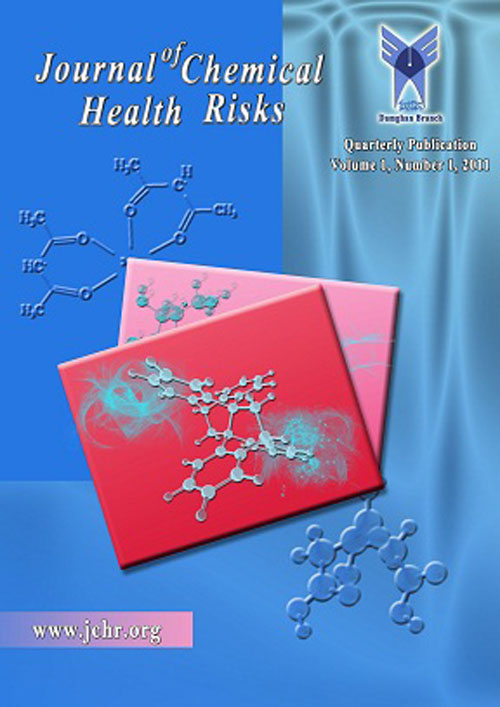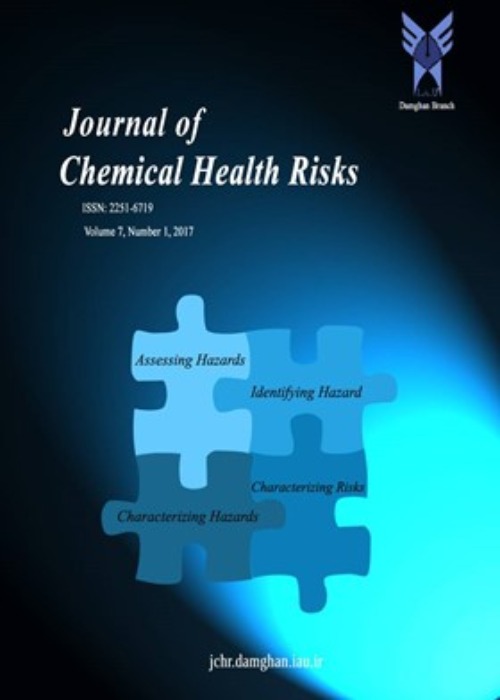فهرست مطالب

Journal of Chemical Health Risks
Volume:6 Issue: 4, Autumn 2016
- تاریخ انتشار: 1395/07/07
- تعداد عناوین: 8
-
-
Biochemical Responses of Two Soybean (Glycine max) Varieties to Aluminum Stress in Nutrient SolutionPage 237Aluminum toxicity is the most widespread form of metal toxicity to plants in soil acids, initially causing inhibition of root elongation and blocks absorption of water and nutrients. According to this fact that soybean has been widely used in industry, this study investigated the effects of aluminum toxicity on biochemical factors in two varieties of Williams and Katoul of soybean plant. The study was carried out in a randomized design with aluminium (0, 200, 500, 700 µM) treatments and four replications in hydroponic culture. Results of biochemical tests showed that aluminum reduced the content of photosynthetic pigments, flavonoids, phenolic compounds, anthocyanins and reduced sugars in both cultivars of soybean. The proline content decreased with increasing aluminum in var. williams, but at var. katoul increased. It seems that G. max var. katoul suffers less than var. Williams. As regards, proline accumulation under Al stress to be generally higher in G. max var. katoul; hence, these results suggest that var. katoul is more resistant than var. Williams.Keywords: Aluminium, Soybean, Photosynthetic Pigments, Phenolic compounds, Proline, Sugar, Flavonoid, Anthocya, nin
-
Page 249Honey is the oldest natural food produced by honeybee and comprises wide variety of valuable ingredients including carbohydrate, proteins, minerals, vitamins, organic acids, polyphenols and flavonoids that contribute to well-known therapeutic properties. This review provide available scientific information on different ways of honey adulteration and chemical contamination with the certain focus on the variety of methods for analyzing the residue levels in honey samples. For data collection, different scientific databases including Science Direct, Springer, PubMed and Magiran were searched. Honey such as other food products at risked to various types of contaminations and adulterations. Microbial and chemical hazards have been reported in various honey samples all over the world. Therefore, its use without knowing the source and its safety may be significant health risks. Honey labeling according to qualitative analysis is very necessary confirmed that health care. Health officials in all countries have to introduce firm regulation and laws that control and regulate honey production, handling, and analysis to ascertain its safety. Obviously, investigation of sensitivity of methods in order to detect the chemical residue levels for preventing the disruptive impacts on consumers health is momentous and all reasonable efforts should be taken for having adequate control over honey production and standardizing the maximum residue levels of chemicals to minimize possible contaminations.Keywords: Honey, Chemical contamination, Methods, Hazards, Adulteration
-
Page 269Alterations in the homeostasis of biomolecules and multiple organ dysfunctions associated with cigarette smoke may suggest a dose dependent mechanism. This study assessed the triiodothyronine (T3), thyroxine (T4), thyrotropin (TSH), calcium (Ca), albumin and vitamin C levels in relation to smoking pack years (SPY) in male active smokers. Ninety consenting males (18-60 yr) comprising of moderate smokers (n=26), light smokers (n=24) and non-smokers (n=40) were studied. Triiodothyronine, thyroxine, TSH and cotinine were determined by ELISA, calcium, albumin and vitamin C by colorimetry. The BMI, calcium, albumin, vitamin C and TSH were higher and cotinine, T3 and T4 lower in non-smokers compared to moderate and light smokers. Light smokers had higher BMI, vitamin C and TSH and lower cotinine, T3 and T4 compared to moderate smokers. In smokers, cotinine correlated positively with SPY (r = 0.838, P = 0.000), T3 (r=0.339, P = 0.005), T4 (r = 0.443, P = 0.001) and negatively with BMI (r = -0.478, P = 0.000), vitamin C (r=-0.407, P=0.003) and TSH (r = -0.510, P = 0.000) while SPY correlated positively with T3 (r=0.586, P = 0.000), T4 (r = 0.608, P = 0.000) and negatively with BMI (r = -0.597, P = 0.000), vitamin C (r = -0.599, P = 0.000), albumin (r = -0.281, P = 0.048) and TSH (r = -0.578, P = 0.000). Cigarette smoking and increasing smoking pack year may be associated with abnormal thyroid function and altered calcium, albumin and vitamin C homeostasis.Keywords: Cigarette, Smokers, Thyroid function, Albumin, Vitamin C, Calcium
-
Page 281In order to investigate the use of natural and healthy treatments and reduction of the risks of using chemicals at the preservative solutions of cut flowers, Eucalyptus extracts (12,25, 50%), rosemary (12, 25, 50%), sour orange (4.5 ml l-1) combined with 4% sucrose were used in vase solution of tuberose. This experiment was performed in a completely randomized design with factorial arrangement in three replications. Traits of vase life, the percentage of opening buds, total soluble solids, solution uptake, relative fresh weight, chlorophyll a, b and total chlorophyll were evaluated. The maximum and minimum vase life were obtained for the flowers treated with Eucalyptus extract of 50% sour orange fruit extract (11.33 days) and control group (6.33 days), respectively. The treatment of rosemary extract of 50% sour orange extract had the highest percentage of the opening buds and relative fresh weight. The highest total soluble solids and solution uptake were related to treatments of Eucalyptus extract of 25% sour orange extract and Eucalyptus extract of 50% sour orange extract, respectively. Flowers treated with Eucalyptus extract of 12% rosemary extract had the maximum chlorophyll a, b and total chlorophyll. The combination of the extracts of rosemary and Eucalyptus with sour orange fruit extract improves the vase life and some physiological traits of it. Since the environment is faced with serious risks, the use of harmful chemicals to extend the life of horticultural products is not explainable. Thus, the use of natural, safe, inexpensive and available for preservative solutions of the cut flowers is an appropriate way to minimize harm to the environment.Keywords: Environment, Natural compounds, Tuberose
-
Page 291The first study on the high efficiency of nanometer-sized magnetic nanoparticles (Fe3O4) coated with sodium dodecyl sulfate (SDS) and dithiooxamide as a new sorbent solid phase extraction has been reported. Modified magnetic nanicomposites was used to preconcentrate and separate Co (II) ions in food and environmental water samples. Magnetic nanoparticles were prepared by chemical precipitation of Fe (II) and Fe (III) salts from aqueous solution by ammonia solution. These magnetic nanoparticles and nanocomposites were characterized by scanning electron microscopy (SEM), transmission electron microscopy (TEM), thermo gravimetric analysis (TGA) and elemental analysis CHNS. A micro sample introduction system was employed for the nebulization micro-volume of diluted solution into flame atomic absorption spectrometry (FAAS). The extraction conditions were optimized by selecting the appropriate extraction parameters including the amount of nanosorbent, pH value, volume of dithiooxamide and condition of eluting solution. The detection limit of this method for Co (II) ions was 1.21 ng ml-1 and the R.S.D. was 0.9% (n=6). The advantages of this new method include rapidity, easy preparation of nanosorbents and a high preconcentration factor. The proposed method has been applied to the determination of Co (II) ions at trace levels in real samples such as, kiwi, orange, cucumber, apple, green pepper, honey, potato, tap water, river water and sea water with satisfactory results.Keywords: Magnetic nanocompo, sites, Fe3O4, Solid phase extraction, Co (II)
-
Page 305Shirin Su Wetland ecosystem, Hamedan Province, western Iran, has a great biodiversity and aesthetic. The distribution and accumulation of heavy metals: Cd, Cr, Cu, Fe, Pb and Zn in sediments were assessed from this wetland in February to May of 2013. The chemical speciation of elements was determined using mixed acid digestion. The results showed that the mean concentrations of metals (microgram per gram dry weight) in sediment samples were: 0.16 for Cd, 23.07 for Cr, 10.62 for Cu, 689.82 for Fe, 27.9 for Pb, 5.01 for Zn. Furthermore the mean concentrations of all metals except Fe in all sediment samples were lower than Threshold Effect Concentration and there are not adverse effects. According to I-geo values, in most stations the sediments quality was classified in unpolluted category. In addition, the sediment samples from station 2 and station 4 accumulated the minimum and maximum mean concentration of metals, respectively. Pearson correlation indicates that the anthropogenic sources of Zn, Fe and Cr are closely related in the sediment from Shirin Su Wetland.Keywords: Sediment, Heavy metal, Contamination factor, Geo, accumulation index, Iran
-
Page 311In the present study a sensitive method for extraction of diazinon in water samples was developed using homogeneous liquid-liquid microextraction via flotation assistance (HLLME-FA). Toluene at microliter volume level was used as extraction solvent. The main advantages of method are high enrichment factor, high recovery, good repeatability and extraction solvent volume at µL level. The influence of several variables on the extraction efficiency was investigated. In the proposed method, the calibration graph was linear in the range of 0.5 - 100 µg L-1 with a detection limit of 0.2 µg L-1. The relative standard deviation (RSD) for four replicate measurements of diazinon was 6.5%. The proposed method is fast, simple, and sensitive without any need for stirring and centrifugation and applied to real water samples, successfully.Keywords: Homogeneous liquid, liquid microextraction, Flotation assistance, Diazinon, Water
-
Page 319Diabetes mellitus is one of the most common diseases of the endocrine system. Barberry (Berberis vulgaris), as a common herb incorporated in treatment of various diseases, is used as anti-itch and anti-microbial medicine as well as lowering blood sugar and blood pressure. In this study, the effects of a hydroalcoholic extract of B. vulgaris on skin wound healing of diabetic rats were investigated. Forty eight male Wistar rats weighting 180 to 230 g were divided into four groups: control group (non-treated non-diabetic rats), sham group (oserin-treated diabetic rats), experimental 1 group (non-treated diabetic rats), experimental 2 group (B. vulgaris extract-treated diabetic rats) and then, 3-cm-length cuts were created on the skin of the dorsal lumbar region and then the wounds were treated on a daily basis. Lesion length measurements were conducted during the experiments using a caliper. For the purpose of histological studies, wound samples were taken from each group and finally, statistical data analysis was conducted using the one-way ANOVA test in addition to the Duncan test performed using the SPSS software. The results indicated that the second experimental group had the best influence on wound healing compared to others. Accordingly, the B. vulgaris extract might be able to improve the wound healing process along with reducing the lesion length due to its anti-diabetic and antimicrobial effects in rats after 21 days.Keywords: Diabetes, Barberry, Skin lesions, Rats


